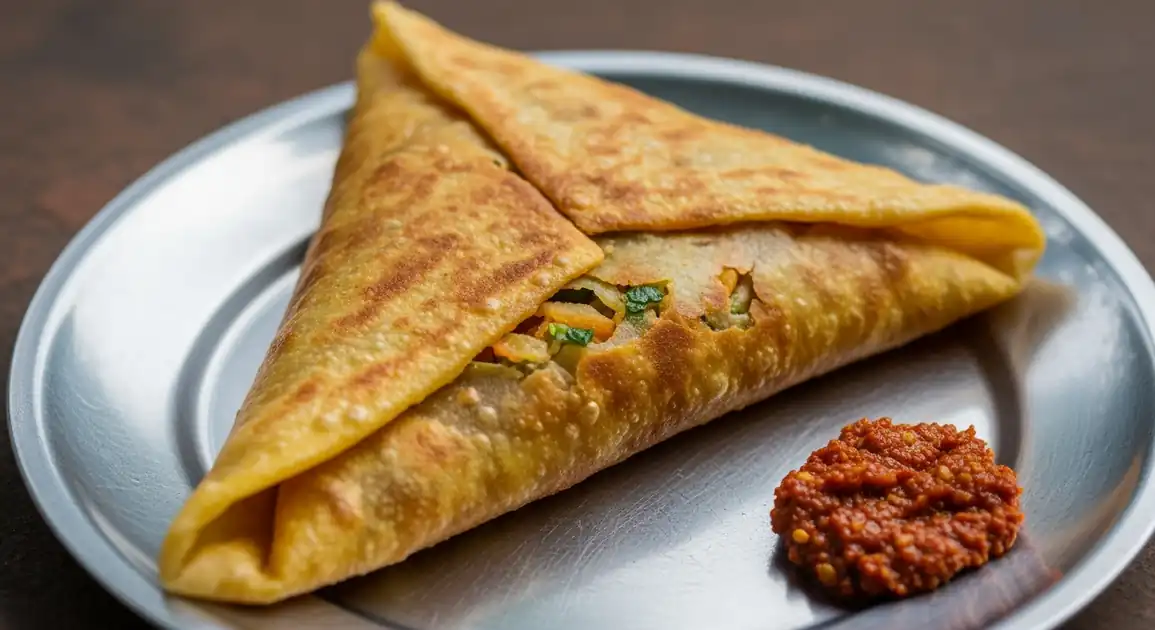Elawalu Roti (Vegetable Roti)
එළවළු රොටී

Description
In Galle, like the rest of Sri Lanka, Elawalu Roti is a readily available and popular 'short eat'. You'll find it at numerous street stalls, particularly near the bus stand and Galle Fort entrance, as well as in local bakeries scattered throughout the town and its surroundings.
Dietary Information
Serving information
Serving style
Typically served hot in a paper or plastic wrapper for takeaway. Eaten by hand. Chili paste or ketchup might be offered.
Quick facts
Street vendors: Typically 7 AM - 6 PM. Bakeries: Often 7 AM - 7 PM or later.
Safety Tips
What to Look For
-
Cooked fresh to order on a hot griddle
Ensures the roti is served hot, cooked thoroughly, and minimizes time for bacterial growth.
-
Clean griddle ('thachchiya') and utensils
Reduces risk of contamination from previous batches or unclean surfaces.
-
Vendor uses clean hands, gloves, or utensils to handle food
Basic food hygiene practice to prevent contamination.
-
Fresh-looking vegetable filling
Ensures the core ingredients are safe and taste good. Avoid fillings that look dry, old, or discolored.
-
High customer turnover
Indicates popularity and that the roti is likely made frequently and served fresh.
What to avoid
-
Roti that has been sitting uncovered for a long time
Increased risk of contamination from dust, flies, and bacterial growth at ambient temperatures.
-
Vendors with poor personal hygiene or dirty cooking area
General lack of cleanliness increases the risk of foodborne illness.
-
Roti that looks undercooked or doughy
Indicates it might not have reached a safe internal temperature.
-
Visible cross-contamination between raw ingredients (if any) and cooked roti
Less common for roti itself, but observe general handling practices.
Price information
Price range
Budget tips
- Street stalls near the main bus stand often offer the lowest prices.
- Bakeries inside Galle Fort might be slightly more expensive due to the tourist location.
- Look for small, local 'petti kade' stalls just outside the main tourist areas for better value.
Value indicators
- Made fresh on the spot.
- Good balance of flaky pastry and generous vegetable filling.
- Served hot.
- Reasonable size for the price.
Where to Find This Dish
Galle Bus Stand Area
Numerous stalls and small eateries around the main bus station offer various short eats including Elawalu Roti.
Galle Central Bus Station
Morning, Afternoon
Galle Fort Entrance / Ramparts
Vendors often set up near the entrance or along the ramparts, catering to both locals and tourists.
Galle Fort Gate, Dutch Hospital Shopping Precinct (nearby)
Afternoon, Evening
Local Bakeries (Town Area)
Explore bakeries along main streets in Galle town outside the Fort for authentic, reasonably priced options.
Main Street (Galle Town), Sea Street
Morning, Afternoon
Vendor Tips
- Vendors near the Fort entrance may be used to tourists; specify spice preference clearly.
- Observe if they are cooking continuously, indicating freshness.
- Compare prices between stalls, especially in tourist-heavy spots.
- Try bakeries slightly away from the main tourist drag for potentially more authentic flavor.
How to Order
Regional Variations
-
Seafood-influenced fillings (less common for Elawalu Roti)
(Muhudu ఆహార Puranaya)
While Elawalu Roti is typically vegetarian, Galle's coastal location means nearby stalls might offer excellent Fish Roti ('Malu Roti') alongside the vegetable version.
-
Sweeter Vegetable Mix
(Pænirasa Elawalu Puranaya)
Some local variations might have a slightly sweeter undertone in the vegetable filling compared to other regions, though still predominantly savory.
Cultural context
History
Originating as part of Sri Lanka's diverse 'short eats' culture, influenced by South Indian and Malay cuisines, Elawalu Roti became a staple street food and bakery item. It's an affordable and filling snack enjoyed by people from all walks of life across the island. The use of Godhamba roti technique (stretching and folding thin dough) is key to its texture.
Local significance
A staple snack for locals in Galle, enjoyed during breaks or commutes. Represents the everyday food culture beyond the tourist-focused restaurants in the Fort.
Eating customs
- Eaten casually by hand, often bought as a quick takeaway snack.